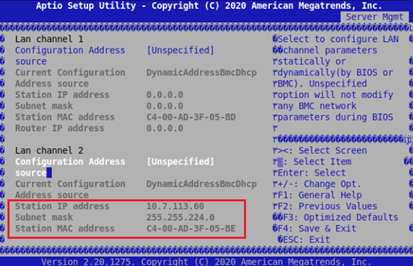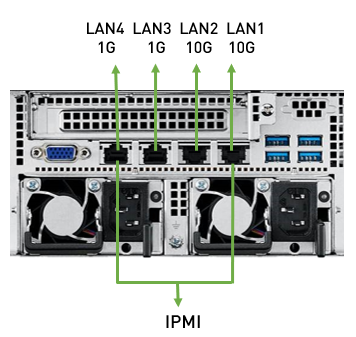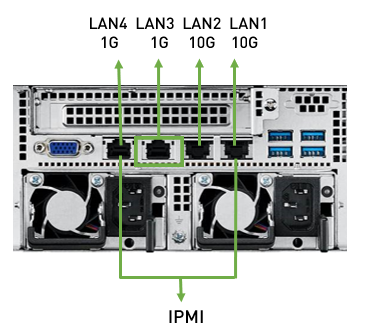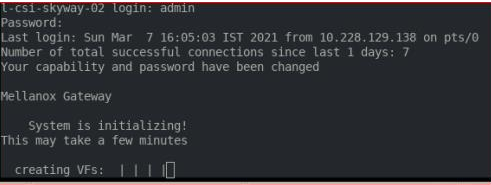Configuring the Gateway for the First Time
To initialize the gateway, follow the steps below.
Enable remote access to serial console via IPMI.
WarningSteps a through d, below, instruct how to find the MAC address for the IPMI port from inside the BIOS, even though the outside of the chassis is labeled with the IPMI port MAC address.
Connect a VGA monitor and USB keyboard directly to the NVIDIA Skyway appliance.
To enter the BIOS, reboot the NVIDIA Skyway appliance and press <DEL> during bootup until the BIOS window pops up.
Go to “Server Mgmt.” tab → “BMC network configuration."
The “Station IP address” is the address of the IPMI controller. DHCP may need to be configured in order to provide a lease for the MAC address. The NVIDIA Skyway appliance has 2 LAN ports on the back panel of the appliance that can be used for IPMI (in the figure below IPMI LAN2 is used).


Use the following IPMI command to remotely access serial console (user and password should be “admin” by default).
ipmitool -I lanplus -H <IPMI_CONTROLLER_IP> -U <user> -P <password> sol activate
Example:
ipmitool -I lanplus -H
10.7.113.60-U admin -P admin sol activate
WarningMake sure to connect to the console SOL port of the gateway and not to the management port. Of the four ports, either of the outer ports (1st or 4th port—either to IPMI LAN1 or IPMI LAN 4, in the image above) can be selected to be the SOL port.
WarningOnce operating system boots, iKVM over HTML5 no longer shows any output. However, iKVM over HTML5 can be used for BIOS configurations at the very beginning of the system boot sequence right before the operating system boots.
Configure Console Redirection. This configuration allows to use remote IPMI to see all serial output that comes after the initial boot, useful for monitoring the OS init flow.
Go to “Advanced” tab → “Serial Port Console Redirection” → Under “Serial Communication via IPMI COM".
Set “Console Redirection” to “Enabled”.
ImportantAt this point, make sure to disconnect the VGA monitor and USB keyboard, or else the following error may appear:
TSC_DEADLINE disabled due to Errata; Please update microcode to version : 0xffffffff or later
Log in as admin and use admin as password, using IPMI.
ipmitool -I lanplus -H <IP Address> -U admin -P admin sol activate
Connect the management Ethernet cable to LAN3 (second port from the left) on the back panel of the appliance.

Go through the Gateway Management configuration wizard.
IP Configuration by DHCP
Wizard Session Display (Example)
Comments
Do you want to use the wizard for initial configuration? yes
This configuration must be performed the first time the gateway is operated or after resetting the gateway to the factory defaults.
Type “y” and then press <Enter>.Step 1: Hostname? [gateway-1]
To accept the default hostname, press <Enter>.
Otherwise, type a different hostname and press <Enter>.Step 2: Use DHCP on mgmt0 interface? [yes]
Perform this step to obtain an IP address for the gateway (mgmt0 is the management port of the gateway).
Typing “yes” will have the DHCP server assign the IP address
Typing “no” (no DHCP) will offer the use of the “zeroconf” configuration or not. For the use of Zeroconf, type "yes" and the session will continue. If “no” (no Zeroconf) is typed, enter a static IP and the session will continue.
Step 3: Enable IPv6 [yes]
Perform this step to enable IPv6 on management ports.
Type "yes" to enable enable IPv6.
Type “no” to not enable IPv6 (Step 4 will be skipped)
Step 4: Enable IPv6 autoconfig (SLAAC) on mgmt0 interface
Perform this step to enable StateLess address autoconfig on external management port.
Type "yes" to enable
Type "no" to disable
Step 5: Use DHCPv6 on mgmt0 interface? [yes]
Perform this step to enable DHCPv6 on the MGMT0 interface.
Step 6: Enable password hardening?
Perform this step to enable/disable password hardening on your machine. If enabled, new passwords will be checked upon configured restrictions. If you wish to enable it, type “yes” and press . If you wish to disable it, enter “no”
Step 7: Admin password (Must be typed)? <new_password>
To avoid illegal access to the machine, type a password and press <Enter>.
An admin password must be entered upon initial configuration. Due to California Senate Bill No. 327, this stage is required and cannot be skipped.
Step 8: Confirm admin password? <new_password>
Confirm the password by re-entering it. Note that password characters are not printed.
Step 9: Monitor password (Must be typed)? <new_password>
To avoid illegal access to the machine, please type a password and then press <Enter>.
An admin password must be entered upon initial configuration. Due to California Senate Bill No. 327, this stage is required and cannot be skipped.
Step 10: Confirm monitor password? <new_password>
Confirm the password by re-entering it. Note that password characters are not printed.
You have entered the following information:
Hostname: <gateway name>
Use DHCP on mgmt0 interface: yes
Enable IPv6: yes
Enable IPv6 autoconfig (SLAAC) on mgmt0 interface: yes
Enable DHCPv6 on mgmt0 interface: no
Enable password hardening: yes
Admin password (Enter to leave unchanged): (CHANGED)
To change an answer, enter the step number to return to.
Otherwise hit <enter> to save changes and exit.
Choice: <Enter>
Configuration changes saved.
To return to the wizard from the CLI, enter the “configuration jump-start” command
from configuration mode. Launching CLI...
<gateway name> [standalone: master] >The wizard displays a summary of choices and then asks to confirm the choices or to re-edit them.
Press <Enter>, to save changes and exit
Enter the relevant configuration step number, to edit any of the choices
To run the command “configuration jump-start”, Config mode must be used.
Check the mgmt0 interface configuration before attempting a remote connection (e.g., SSH) to the gateway. Specifically, verify the existence of an IP address.
gateway # show interfaces mgmt0 Interface mgmt0 status: Comment : Admin up : yes Link up : yes DHCP running : yes IP address :
10.7.148.61Netmask :255.255.0.0IPv6 enabled : yes Autoconf enabled: no Autoconf route : yes Autoconf privacy: no DHCPv6 running : no IPv6 addresses :1IPv6 address: fe80::268a:7ff:fe53:3d8e/64Speed : 1000Mb/s (auto) Duplex : full (auto) Interface type : ethernet Interface source: physical MTU :1500HW address :00:02:c9:11:a1:b2 Rx:11700449bytes55753packets0mcast packets0discards0errors0overruns0frame Tx:5139846bytes28452packets0discards0errors0overruns0carrier0collisions1000queue len
Rerunning the Wizard
To rerun the wizard, do the following:
Enter config mode.
gateway > enable gateway # config terminal
Rerun the wizard.
gateway (config) # configuration jump-start
Set up an Ethernet connection between the gateway and a local network machine using a standard SOL connector.
Start a remote secured shell (SSH) to the gateway using the command “ssh -l <username> <gateway ip address>”.
rem_mach1 > ssh -l <username> <ip address>
Log in to the gateway (default username and password are both "admin").
Read and accept the EULA, when prompted.
Once the following prompt appears, the system is ready to use.
-
NVIDIA Gateway Password: Last login: <time> from <ip-address> gateway >
-
If firmware was upgraded, firmware boot bar will appear and the CLI will be blocked until firmware upgrade is complete.
The CLI will be blocked until InfiniBand virtual interfaces are created. The following message will appear : "Creating VFs".
